Practice Free AZ-204 Exam Online Questions
You develop Azure Web Apps for a commercial diving company. Regulations require that all divers fill out a health questionnaire every 15 days after each diving job starts.
You need to configure the Azure Web Apps so that the instance count scales up when divers are filling out the questionnaire and scales down after they are complete.
You need to configure autoscaling.
What are two possible autoscaling configurations to achieve this goal? Each correct answer presents a complete solution. NOTE: Each correct selection is worth one point.
- A . Predictive autoscaling
- B . CPU usage-based autoscaling
- C . Recurrence profile
- D . Fixed date profile
Note: This question is part of a series of questions that present the same scenario. Each question in the series contains a unique solution that might meet the stated goals. Some question sets might have more than one correct solution, while others might not have a correct solution.
After you answer a question in this section, you will NOT be able to return to it. As a result, these questions will not appear in the review screen.
You are developing an Azure Service application that processes queue data when it receives a message from a mobile application. Messages may not be sent to the service consistently.
You have the following requirements:
✑ Queue size must not grow larger than 80 gigabytes (GB).
✑ Use first-in-first-out (FIFO) ordering of messages.
✑ Minimize Azure costs.
You need to implement the messaging solution.
Solution: Use the .Net API to add a message to an Azure Storage Queue from the mobile application.
Create an Azure Function App that uses an Azure Storage Queue trigger.
Does the solution meet the goal?
- A . Yes
- B . No
B
Explanation:
Create an Azure Function App that uses an Azure Service Bus Queue trigger.
Reference: https://docs.microsoft.com/en-us/azure/azure-functions/functions-create-storage-queue-triggered-function
HOTSPOT
You are configuring a development environment for your team. You deploy the latest Visual Studio image from the Azure Marketplace to your Azure subscription.
The development environment requires several software development kits (SDKs) and third-party components to support application development across the organization. You install and customize the deployed virtual machine (VM) for your development team. The customized VM must be saved to allow provisioning of a new team member development environment.
You need to save the customized VM for future provisioning.
Which tools or services should you use? To answer, select the appropriate options in the answer area. NOTE: Each correct selection is worth one point.
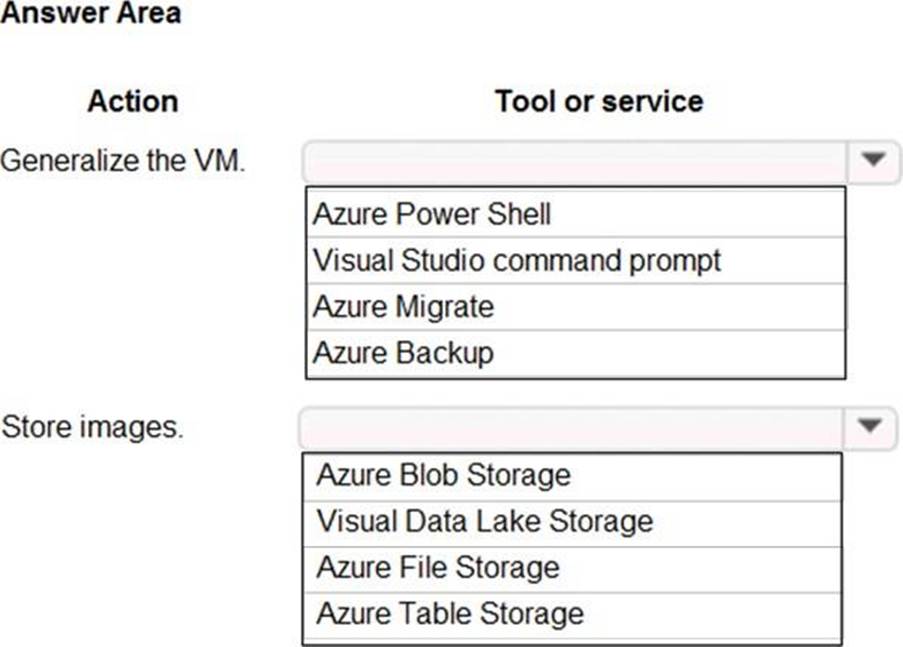
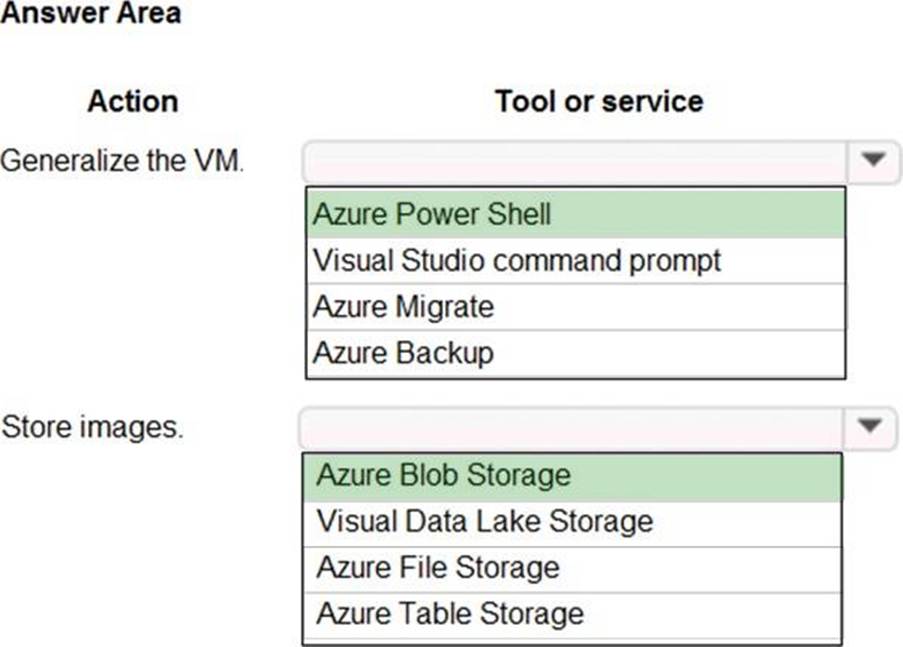
Explanation:
Box 1: Azure Powershell
Creating an image directly from the VM ensures that the image includes all of the disks associated with the VM, including the OS disk and any data disks.
Before you begin, make sure that you have the latest version of the Azure PowerShell module.
You use Sysprep to generalize the virtual machine, then use Azure PowerShell to create the image.
Box 2: Azure Blob Storage
Reference: https://docs.microsoft.com/en-us/azure/virtual-machines/windows/capture-image-resource#create-an-image-of-a-vm-using-powershell
DRAG DROP
You are developing an ASP.NET Core website that can be used to manage photographs which are stored in Azure Blob Storage containers.
Users of the website authenticate by using their Azure Active Directory (Azure AD) credentials.
You implement role-based access control (RBAC) role permissions on the containers that store photographs. You assign users to RBAC roles.
You need to configure the website’s Azure AD Application so that user’s permissions can be used with the Azure Blob containers.
How should you configure the application? To answer, drag the appropriate setting to the correct location. Each setting can be used once, more than once, or not at all. You may need to drag the split bar between panes or scroll to view content. NOTE: Each correct selection is worth one point.


Explanation:
Box 1: user_impersonation
Box 2: delegated
Example:
DRAG DROP
You are developing an application to use Azure Blob storage. You have configured Azure Blob storage to include change feeds.
A copy of your storage account must be created in another region. Data must be copied from the current storage account to the new storage account directly between the storage servers.
You need to create a copy of the storage account in another region and copy the data.
In which order should you perform the actions? To answer, move all actions from the list of actions to the answer area and arrange them in the correct order.
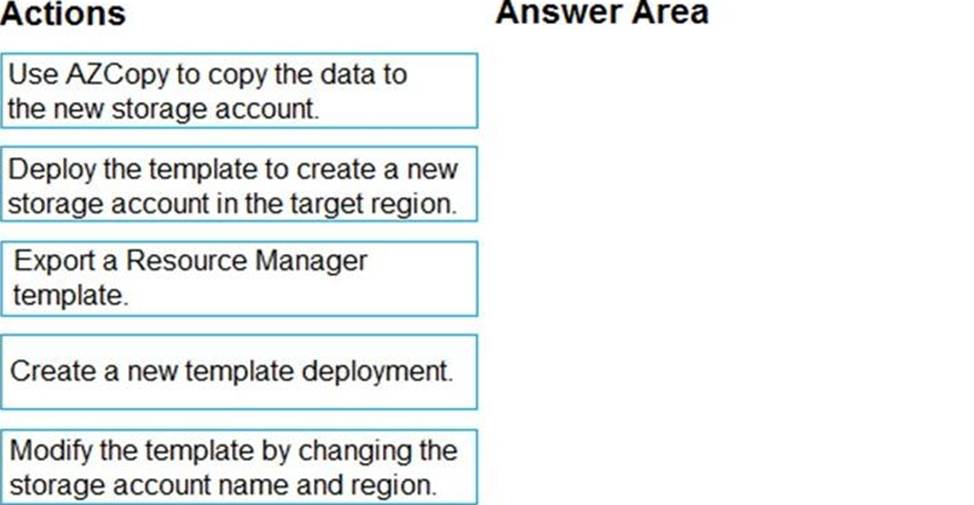
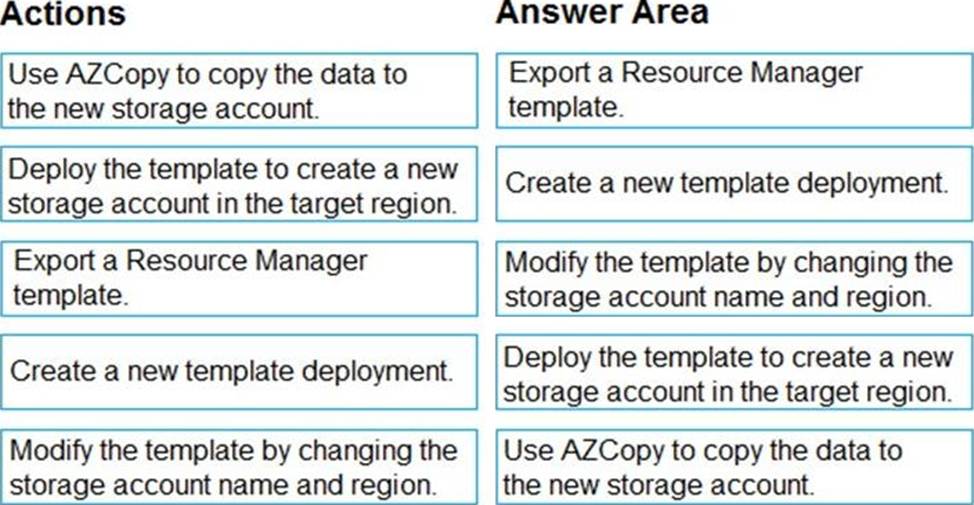
Explanation:
https://docs.microsoft.com/en-us/azure/storage/common/storage-account-move?tabs=azure-portal#modify-the-template
HOTSPOT
A company is developing a mobile app for field service employees using Azure App Service Mobile Apps as the backend.
The company’s network connectivity varies throughout the day. The solution must support offline use and synchronize changes in the background when the app is online app.
You need to implement the solution.
How should you complete the code segment? To answer, select the appropriate options in the answer area. NOTE: Each correct selection is worth one point.
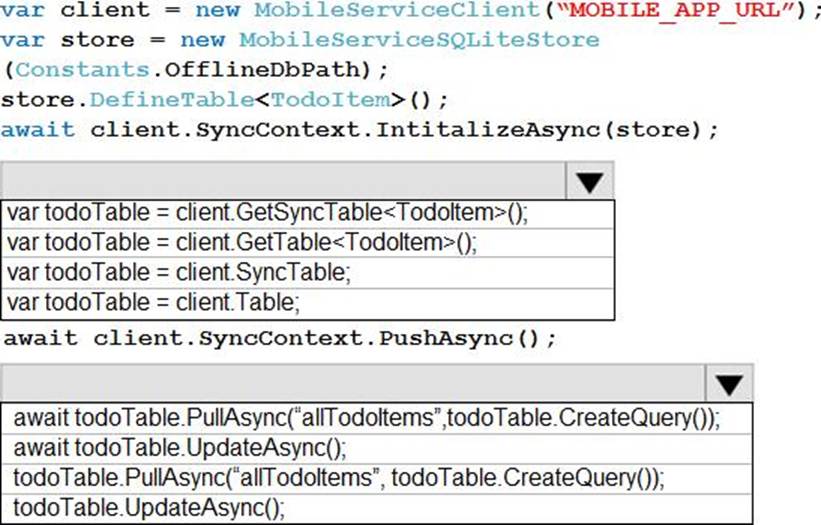
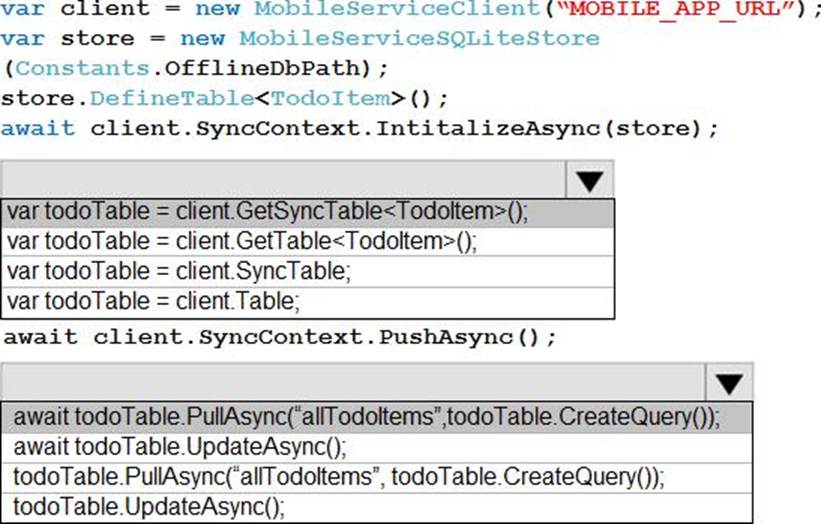
Explanation:
Box 1: var todoTable = client GetSyncTable<TodoItem>()
To setup offline access, when connecting to your mobile service, use the method GetSyncTable instead of GetTable (example):
IMobileServiceSyncTable todoTable = App.MobileService.GetSyncTable(); /
Box 2: await todoTable.PullAsync("allTodoItems",todo.Table.CreateQuery());
Your app should now use IMobileServiceSyncTable (instead of IMobileServiceTable) for CRUD operations. This will save changes to the local database and also keep a log of the changes. When the app is ready to synchronize its changes with the Mobile Service, use the methods PushAsync and PullAsync (example):
await App.MobileService.SyncContext.PushAsync();
await todoTable.PullAsync();
Reference: https://azure.microsoft.com/es-es/blog/offline-sync-for-mobile-services/
You develop a solution that uses an Azure SQL Database to store user information for a mobile app.
The app stores sensitive information about users.
You need to hide sensitive information from developers that query the data for the mobile app.
Which three items must you identify when configuring dynamic data masking? Each correct answer presents a part of the solution. NOTE: Each correct selection is worth one point.
- A . Column
- B . Table
- C . Trigger
- D . Index
- E . Schema
ABE
Explanation:
In the Dynamic Data Masking configuration page, you may see some database columns that the recommendations engine has flagged for masking. In order to accept the recommendations, just click Add Mask for one or more columns and a mask is created based on the default type for this column. You can change the masking function by clicking on the masking rule and editing the masking field format to a different format of your choice.
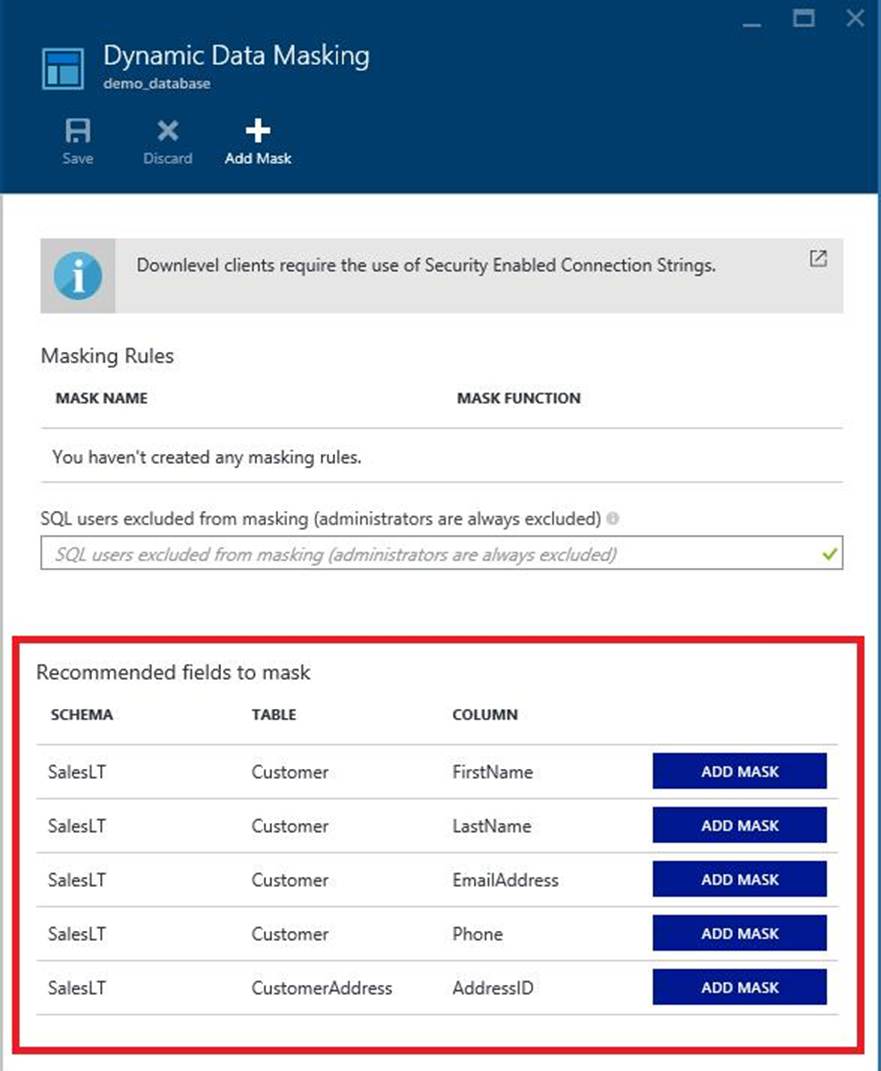
Reference: https://docs.microsoft.com/en-us/azure/sql-database/sql-database-dynamic-data-masking-get-started-portal
You need to support the requirements for the Shipping Logic App.
What should you use?
- A . Azure Active Directory Application Proxy
- B . Point-to-Site (P2S) VPN connection
- C . Site-to-Site (S2S) VPN connection
- D . On-premises Data Gateway
D
Explanation:
Before you can connect to on-premises data sources from Azure Logic Apps, download and install the on-premises data gateway on a local computer. The gateway works as a bridge that provides quick data transfer and encryption between data sources on premises (not in the cloud) and your logic apps.
The gateway supports BizTalk Server 2016.
Note: Microsoft have now fully incorporated the Azure BizTalk Services capabilities into Logic Apps and Azure App Service Hybrid Connections.
Logic Apps Enterprise Integration pack bring some of the enterprise B2B capabilities like AS2 and X12, EDI standards support
Scenario: The Shipping Logic app must meet the following requirements:
Support the ocean transport and inland transport workflows by using a Logic App.
Support industry-standard protocol X12 message format for various messages including vessel content details and arrival notices.
Secure resources to the corporate VNet and use dedicated storage resources with a fixed costing model.
Maintain on-premises connectivity to support legacy applications and final BizTalk migrations.
Reference: https://docs.microsoft.com/en-us/azure/logic-apps/logic-apps-gateway-install
You are creating an Azure key vault using PowerShell. Objects deleted from the key vault must be kept for a set period of 90 days.
Which two of the following parameters must be used in conjunction to meet the requirement? (Choose two.)
- A . EnabledForDeployment
- B . EnablePurgeProtection
- C . EnabledForTemplateDeployment
- D . EnableSoftDelete
HOTSPOT
You have a web service that is used to pay for food deliveries. The web service uses Azure Cosmos DB as the data store.
You plan to add a new feature that allows users to set a tip amount. The new feature requires that a property named tip on the document in Cosmos DB must be present and contain a numeric value.
There are many existing websites and mobile apps that use the web service that will not be updated to set the tip property for some time.
How should you complete the trigger? NOTE: Each correct selection is worth one point.
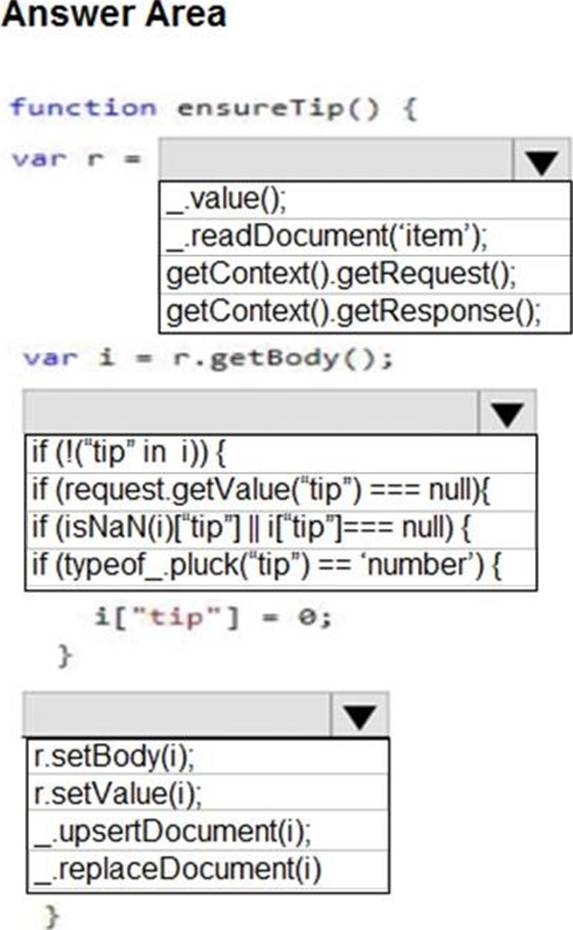
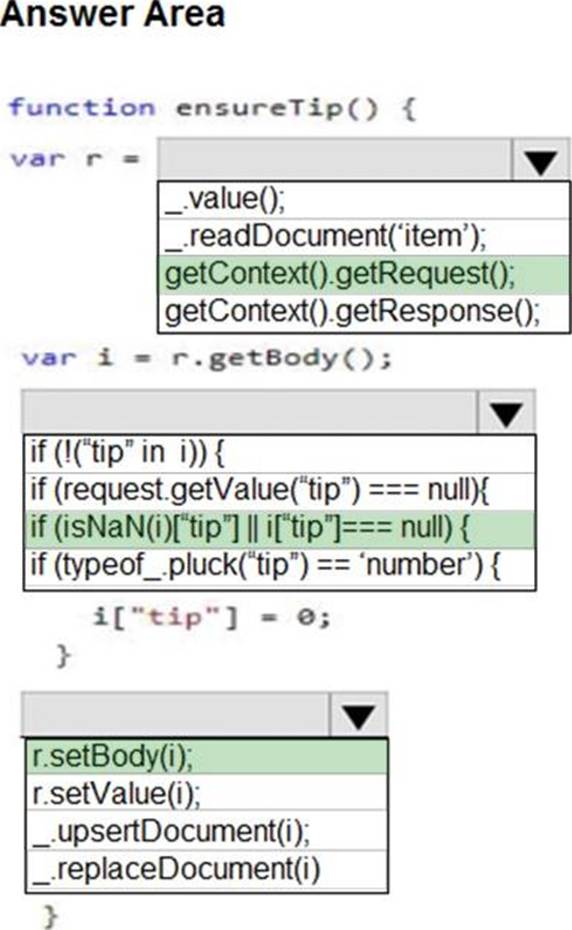
Explanation:
Box 1: getContext().getRequest();
Box 2: if(isNaN(i)["tip"] ..
In JavaScript, there are two ways to check if a variable is a number :
isNaN() C Stands for “is Not a Number”, if variable is not a number, it return true, else return false.
typeof C If variable is a number, it will returns a string named “number”.
Box 3:r.setBody(i);
// update the item that will be created
Reference:
https://docs.microsoft.com/bs-latn-ba/azure/cosmos-db/how-to-write-stored-procedures-triggers-udfs
https://mkyong.com/javascript/check-if-variable-is-a-number-in-javascript/
